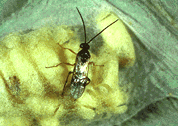Common name: Cotesia wasp, Cotesia
Scientific name:
Cotesia spp.
Hymenoptera:Braconidae
Type
Larva parasitiods
Hosts
Armyworm, bollworm, cabbage looper, cabbageworm, celery looper, corn earworm, cutworm, diamondback moth, gypsy moth, hornworm, stem borer, tobacco budworm, webworm
Description
Eggs are ovate, clear, and shiny and increase in size after they are laid. They hatch 2 days later.
The first instar parasitoid larvae begin feeding internally after 3-4 days. The immature parasitoids
develop through three larval instars in the host body, and then emerge from the host by chewing through the skin. After emergence from the host, the last instar larvae immediately spin cocoons and pupate.
Pupae vary according to species; some are either in an irregular mass of yellow silken cocoons attached to the host larva or to plant leaves, and some in white cocoon, about a size of rice grain. The cocoons are usually found inside host feeding tunnels in leguminous plants. Pupation takes 4-6 days after which adults emerge.
Adults are small wasps, about 3-7mm in length. They are dark-colored and look like flying ants or tiny flies. They have two pairs of wings and chewing-lapping mouthparts. They have curved antennae, the males having much shorter antennae than the females. A female abdomen has a downward curve extension, called the ovipositor- with which she lays her eggs. The adult female looks for hosts in leaves and in tunnels of crops. Some species lay about 15-65 eggs in
the body cavity of the host while some lay a single egg. A single wasp can parasitize 200-300 host caterpillars during its 10 to 14-day life. The life cycle, from egg to adult, is approximately 15-30 days, depending on the species and the temperature.
Conservation
Cotesia wasps can be conserved by planting flowering herbs as a source of food for the adults such as; wild carrot, wild mustard, and sweet alyssum.
External links
References
- Johanowicz, L.; Mitchell, E. (2000): Effects of sweet alyssum flowers on the longevity of the parasitoid wasps Cotesia marginiventris (Hymenoptera : Braconidae) and Diadegma insulare (Hymenoptera : Ichneumonidae). Florida Entomologist 83(1):41-47
- Kfir, R. (1992): Parasitoids of the African stem borer, Busseola fusca (Lepidoptera: Noctuidae), in South Africa. Bull. Entomol. Res. Vol. 85. pp. 369-377
- Mason, P. Huber, J. Editors. (2002): Biological control programmes in Canada, 1981-2000. CABI Publishing. CAB International, Wallingford, UK.

